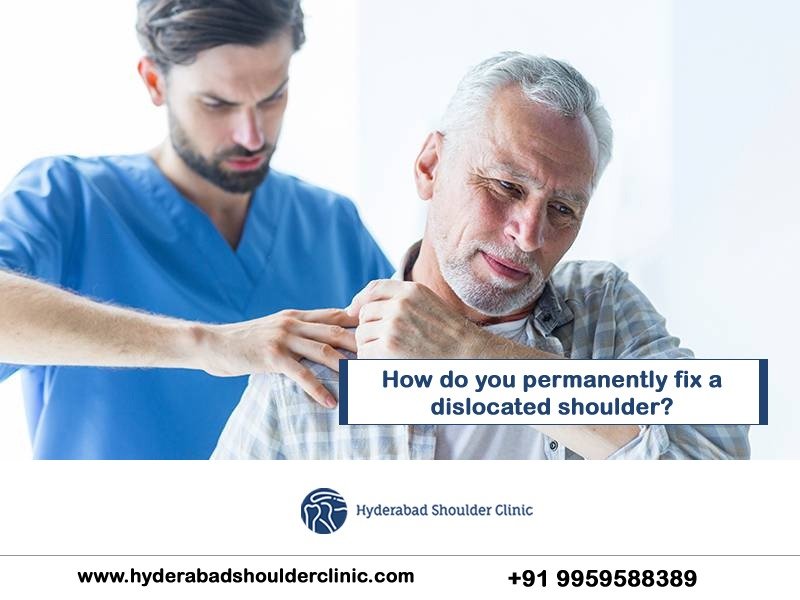A dislocated shoulder is when the ball of the shoulder joint comes out of the socket. It must be returned to its proper position by a medical professional. Reducing the shoulder is a process of “popping” a dislocated shoulder back into place. Reducing must be done with great care to avoid damaging tissues, nerves, and blood vessels in and around the shoulder joint.
One can have a partial (subluxation) or complete (luxation) dislocation.
What are the common symptoms to look out for in case of a shoulder dislocation?
- Severe shoulder pain
- Swelling and bruising of your shoulder or upper arm
- Numbness and/or weakness in your arm, neck, hand, or fingers
- Trouble moving your arm
- Your arm looks to be out of place
- Muscle spasms in your shoulder
If you have any of these symptoms, should seek medical attention as early as possible.
Complications due to a dislocated shoulder
- Permanent nerve injury
- Avascular necrosis (bone death due to impaired blood flow)
- Loss of joint mobility and range of motion
Medical detection of Dislocated Shoulder
A well-experienced shoulder expert like Dr B. Chandra Sekhar will inspect the affected area for tenderness, swelling or deformity and check for nerve or blood vessel injury signs. They will get an X-ray conducted of the shoulder joint. The X-Ray can show the dislocation and possibly reveal broken bones or other damage to the shoulder joint.
Permanent Treatment to fix a dislocated shoulder
Dislocated shoulder treatment involves
The various treatments for dislocated shoulder include the following methods :
Closed reduction: This procedure involves performing some gentle manoeuvres, which might help move the shoulder bones back into position. Based on factors such as the intensity of pain and swelling, a muscle relaxant or sedative or, rarely, a general anaesthetic might be given before moving the shoulder bones. Once the shoulder is back in place, the severe pain should improve almost immediately.
Shoulder Surgery: Surgery is for those with weak shoulder joints or ligaments who have repeated shoulder dislocations despite strengthening and rehabilitation. Young athletes involved in sports that require frequent throwing or colliding have an increased risk of recurring dislocations. For some, the damaged nerves or blood vessels might require surgery.
The main advantage of surgical treatment is that it reduces the risk of re-injury in young athletes. Most of the time, orthopaedic surgeons perform minimally invasive surgery. This surgery does not require an overnight hospital stay and speeds up recovery.
Types of Shoulder Surgeries for permanent fixing of Dislocated Shoulder
Arthroscopic Surgery
Arthroscopic surgery is performed using a slim, pencil-sized instrument called an arthroscope inserted into the joint through a small incision. The arthroscope will have a video camera and a light at one end. This camera will send a live video of the inside of the shoulder to a nearby monitor. This joint interior is magnified to show tiny details in the bones, tendons, ligaments, and labrum.
Once the arthroscope is in the correct position, the surgeon inserts small surgical tools through a small incision. Under video guidance, the surgeon repositions a torn ligament or labrum to the bone. General anaesthesia is given. Arthroscopy is an outpatient procedure, and doctors may prescribe pain medication.
Surgery is followed by immobilizing the arm and shoulder using a sling for four to six weeks while the soft tissues heal. After six weeks, doctors encourage three to six months of physiotherapy.

Open Shoulder Surgery
Even after arthroscopic surgery, if the shoulder weakness or pain persists or an imaging test shows changes in the shape of the joint bones, a surgeon may recommend open surgery.
The name Open suggests that surgeons access the joint through a single incision made above the shoulder joint. Open surgery repairs injured tendons, ligaments, or the labrum or addresses damage to the joint’s bones.
After open surgery, some return home the same day, and others must remain in the hospital overnight.
After going home, use a sling for two to six weeks to give your shoulder a chance to heal without bearing weight. Doctors will recommend physiotherapy for four to eight weeks.
Initially, you will start with heat and massage therapy to relieve pain and inflammation. As the pain recedes, you will start stretching and strengthening exercises for your shoulder, arm, and upper back muscles to restore your range of motion and provide long-term stability.

Immobilization: After closed reduction, one has to wear a special splint or sling for a few weeks. Immobilization will largely help in keeping the shoulder from moving while it heals.
The sling must be worn properly, otherwise, it might delay healing or injure your arm more. The sling should not prevent fluid and blood from pooling in your hand.
To wear a sling, pull the sling over your arm and elbow gently, and it should fit snugly around the elbow. Place your hand at the very end of the sling, and it shouldn’t cut into your wrist or hand. If the hand is flopping down, your sling may be too small. Take your hand around your neck, grab the strap behind your elbow, pull it around the back of your neck, and push it through the loop near your hand. Tighten the straps so that the hand and forearm are elevated above your elbow level. Using Velcro fasteners, attach the strap. One can also place a small soft cloth under the strap to make it more comfortable around your neck.
A pain reliever or a muscle relaxant might provide comfort while the shoulder heals.

Rehabilitation: After the splint or sling is removed, a rehabilitation program can help restore the shoulder joint’s range of motion, strength and stability.
If the shoulder dislocation is without major nerve or tissue damage, it will likely improve in a few weeks. Remaining a full range of motion without pain and strength may require a few more weeks. Do not resume any activity too soon after shoulder dislocation. It may lead to a re-injury of the shoulder joint.
When might you have to fix your own dislocated shoulder?
Many do not need to know how to fix a shoulder dislocation, but it is particularly helpful for those who engage in activities in remote areas of wilderness where help could be days away.
This might include:
- Hikers
- Kayakers
- Rock climbers
- Outdoor athletes
Dr Chandra Sekhar B is a highly skilled and experienced shoulder surgeon. Visit our website https://hyderabadshoulderclinic.com/ or reach us at +919959588389, shoulderandsportsclinic@gmail.com.





